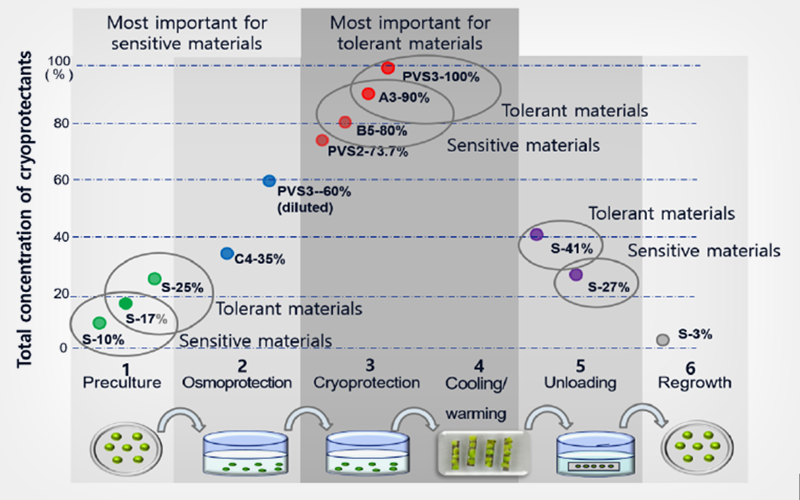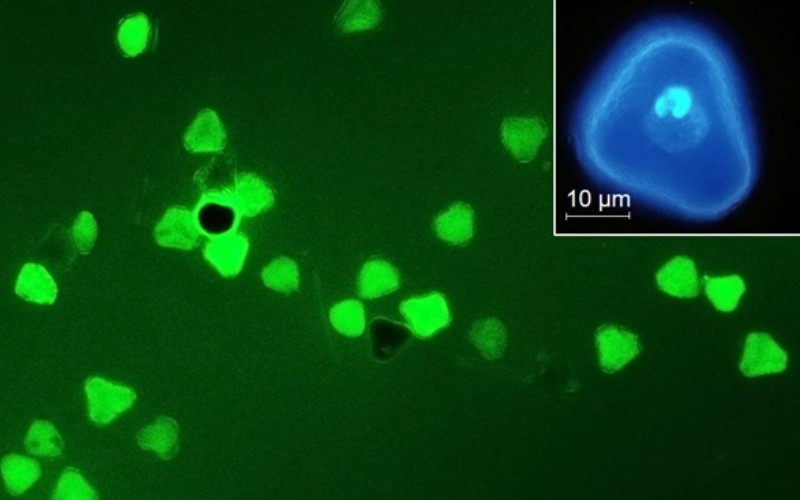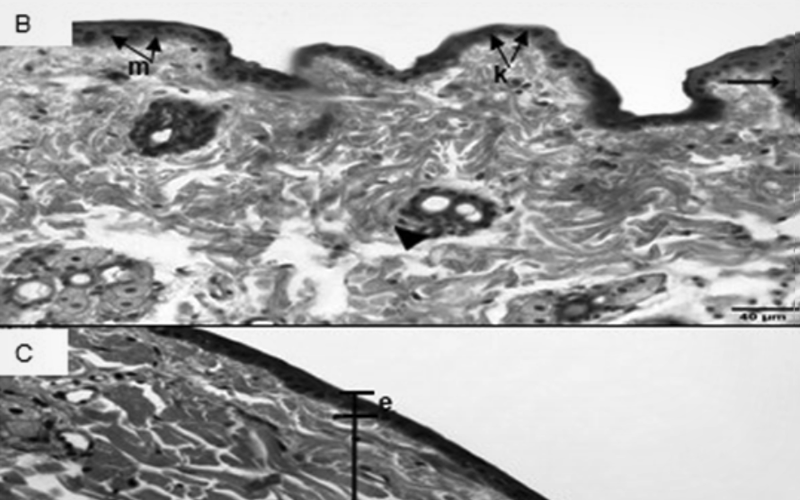CryoLetters Volume 44 - Issue 1
CryoLetters 44 (1), 1–12 (2023)
© CryoLetters, editor@cryoletters.org
doi.org/10.54680/fr23110110112
PERSPECTIVE: Unifying principles of cryopreservation protocols for new plant materials based on alternative cryoprotective agents (CPAs) and a systematic approach
Haeng-Hoon Kim1 and Elena Popova2
- Department of Agricultural Life Science, Sunchon National University, Suncheon, 57922, Korea.
- К.А. Timiryazev Institute of Plant Physiology of Russian Academy of Sciences, Moscow, 127276, Russia
*Corresponding authors’ E-mails: cryohkim@scnu.ac.kr and elena_aygol@hotmail.com
Both authors contributed equally to this paper.
Abstract
This review addresses a frequently encountered problem of designing an effective cryopreservation procedure for new (not previously cryopreserved) or difficult plant materials. This problem hinders worldwide efforts of applying cryopreservation across a wide genetic base of wild and a number of cultivated plants. We review recent advances in modifications of routinely applied cryoprotective solutions (CPAs) and suggest a practical approach to protocol development which embraces the physiological complexity of plant tissues as well as a wide spectrum of behaviours under CPA treatment. We suggest that vegetative plant materials are classified into four categories based on their size, structure, and the response to osmotic and chemical stresses provoked by CPA mixtures of varied composition and concentration, including alternative osmoprotection and vitrification solutions. A number of up to 15 preset protocols designed specifically for each category is then applied to the material. The protocols resulting in the best regrowth are then combined into the optimized procedure. The main advantage of this system over a conventional “trial-and-error” search for working cryopreservation protocol is a minimal amount of starting materials required for the tests and a relatively accurate prediction of material behaviour under cryopreservation stress provided by the relatively few CPAs treatments. The unifying principles revealed by this approach could broaden a spectrum of wild species and materials which can be safely conserved by cryopreservation. Also anticipated is application of this approach to plant materials of biotechnological value as well as cultivars of agricultural and horticultural crops which do not respond well to standard protocols developed for their kind.
Keywords: alternative vitrification solutions; droplet vitrification; endangered species; osmoprotection; systematic approach

CryoLetters 44 (1), 13–19 (2023)
© CryoLetters, editor@cryoletters.org
doi.org/10.54680/fr23110110312
Improvement of sperm quality of the depik fish, Rasbora tawarensis, after cryopreservation using antioxidant
Zainal A Muchlisin1,4*, Dian Afriani2, Kartini Eriani2, Iwan Hasri3, Firman M Nur4, Siti Maulida1,4, Luvi S Handayani1, Nur Fadli1,4, Filiz K Kocabas5, Moh N Siti-Azizah6 and Martin Wilkes7
- Department of Aquaculture, Faculty of Marine and Fisheries Sciences, Universitas Syiah Kuala, Banda Aceh 23111, Indonesia
- Faculty of Mathematics and Natural Sciences, Unversitas Syiah Kuala, Banda Aceh 23111, Indonesia
- Veterinary and Fisheries Affair of Aceh Tengah District, Takengon, Indonesia
- Graduate School of Mathematics and Applied Sciences, Universitas Syiah Kuala, Banda Aceh 23111, Indonesia
- Tunceli University, Fisheries Faculty, 62000 Tunceli, Turkey
- Institute of Marine Biotechnology, University Malaysia Terengganu, Kuala Terengganu, Malaysia
- University of Essex, Essex, England
*Corresponding author’s E-mail: muchlisinza@unsyiah.ac.id
Abstract
Background
The cryopreservation of the sperm of the depik fish, Rasbora tawarensis, has previously been developed. However, the quality of the sperm post cryopreservation was not satisfactory and might be improved through the application of antioxidants.
Objective
To determine the most suitable antioxidant for the cryopreservation of the depik fish spermatozoa.
Materials and methods
A completely randomized design with a non-factorial experiment was used and the tested antioxidants were glutathione, β-carotene, ascorbic acid, and butylated hydroxytoluene (BHT) at 6% concentrations. All treatments had three replications. The sperms were collected from 10 male fishes and diluted with Ringer solution in a ratio of 1: 20 (v/v, sperm: Ringer solution). Then 5% DMSO and 5% egg yolk were added to the diluted sperms. Furthermore, 6% of the tested antioxidants were added to the diluents, and then, cryopreservation was carried out in liquid nitrogen for 14 days.
Results
The ANOVA test showed that the application of antioxidants significantly affected the sperm motility, fertility, and hatching rates of the eggs (P> 0.05). Furthermore, the antioxidants also protected the sperm cells during cryopreservation, with glutathione being the best antioxidant.
Conclusion
The application of antioxidants during the cryopreservation of depik fish sperm had a significant effect on motility, fertility and hatchability of eggs post-cryo. Furthermore, glutathione was the most suitable antioxidant.
Keywords: antioxidant; depik fish; glutathione; Laut tawar lake

CryoLetters 44 (1), 20-25 (2023)
© CryoLetters, editor@cryoletters.org
doi.org/10.54680/fr23110110512
Quantitative assessment of oil palm pollen after 23 years of cryobanking
Sachin Sorokhaibam1, Rajesh Tandon1*, Anuradha Agrawal2,3
and K.R. Shivanna4
- Department of Botany, University of Delhi, Delhi 110007, India
- ICAR-National Bureau of Plant Genetic Resources, Pusa Campus, New Delhi-110012, India
- National Agricultural Higher Education Project (NAHEP), Indian Council of Agricultural Research (ICAR), Pusa Campus, New Delhi -110012, India (current address)
- Ashoka Trust for Research in Ecology and the Environment (ATREE), Srirampura, Bengaluru - 560064, India
*Corresponding author’s E-mail: tandon.raj@gmail.com
Abstract
Cryopreservation of pollen grains is an effective means of conserving desired germplasm of crop plants. Cryoconserved pollen are expected to be long-lived and thus can be suitably retrieved to overcome hybridization constraints imposed by a variety of reasons. We ascertained the performance of oil palm pollen grains (Tenera hybrids) that were cryobanked 23 years ago using liquid nitrogen (-196°lC). Cryostored pollen were assessed for viability, in-vitro germinability and vigour. Our analysis showed a marginal decline in viability, assessed through fluorochromatic reaction test, of cryopreserved pollen as compared to fresh ones (pre-storage assessment); however, the viability did not decline in the cryostate since it was last tested 15 years back. On the other hand, germinability and vigour of cryopreserved pollen were maintained to the levels of fresh pollen. Our study, for the first time, demonstrates the amenability of pollen grains for cryopreservation of any plant species beyond a period of two decades in general, and that for oil palm in particular.
Keywords: Arecaceae; in vitro germination; pollen limitation; pollen longevity; pollen storage; pollen viability; pollen vigour

CryoLetters 44 (1), 26-36 (2023)
© CryoLetters, editor@cryoletters.org
doi.org/10.54680/fr23110110712
Cryoprotective effects of longan honey on preantral follicle integrity of rat ovary post vitrification
Nova Anita1,2, Abinawanto1*, Ahmad Aulia Jusuf3,
Anom Bowolaksono1, Huriyah Adani Saoemi4 and Aisyah Safrina4
- Department of Biology, Faculty of Mathematics and Natural Sciences, Universitas Indonesia, Depok 16424, Indonesia
- Cellular and Molecular Mechanism in Biological System Research Group, Department of Biology, Faculty of Mathematics and Natural Sciences, Universitas Indonesia, Depok 16424, Indonesia
- Department of Histology, Faculty of Medicine Universitas Indonesia, Jakarta 10430, Indonesia
- Master’s Programme in Biomedical Sciences, Faculty of Medicine Universitas Indonesia, Jakarta 10430, Indonesia
*Corresponding author’s E-mail: binawanto.ms@sci.ui.ac.id
Abstract
Background
Longan honey (LH) has the potential as a natural extracellular cryoprotectant to maintain the integrity of intact preantral follicles against the cryoinjury during ovarian vitrification.
Objective
This research determined the cryoprotective effects of logan honey on preantral follicles integrity of rat ovary post-vitrification.
Materials and methods
After vitrification, the follicle index was determined by observing the ovarian histological sections made using the paraffin method with hematoxylin-eosin staining and analyzed using Optilab 3.0 and Image Raster software.
Results
The results showed that the combination of ethylene glycol (EG) with LH and a dose variation of 7.5%-15% (KP1-KP4) increased the density of follicles, the number of intact follicles in G2 and G3, with a decrease in the atretic follicles in G1 better compared to the use of EG only (KKP1-KKP2). The differences in the histological structur e of preantral follicles affected the doses of LH needed by each type of follicle to maintain the integrity of the follicular structure from cryoinjury effects. The comparison of the G2 total follicle index values were KKP1 (90.7±18.3), KKP2 (115.6±9.9) < KP1 (193.6±10.7), KP2 (189.3±10.5), KP3 (182.2±27.1) and KP4 (169.4±8.8). Among the variations in the dose of LH 7.5%-15%, the highest increase in the G3 index value was found in primary (51.653±9.791), tertiary (43.119±8.786), secondary (33.885±4.745), and primordial (28.670±2.516) follicles of KP3 (7.5% of LH).
Conclusion
The primary and tertiary follicular stages maintain the best integrity and can be used after the vitrification of rat ovaries.
Keywords: cryoprotection; ethylene glycol; follicular index; integrity; longan honey; preantral follicle

CryoLetters 44 (1), 37-46 (2023)
© CryoLetters, editor@cryoletters.org
doi.org/10.54680/fr23110110212
Effect of supplementation of cryoprotectant solution with hydroxypropyl cellulose for vitrification of bovine oocytes
Min Jee Park1,2, Seung Eun Lee1,2, Jae Wook Yoon2, Hyo Jin Park1,2, So Hee Kim1,2, Seung-Hwan Oh1,2, Do Geon Lee1,2, Da Bin Pyeon2, Eun-Young Kim1,2,3 and Se-Pill Park1,2,3*
- Jeju National University Stem Cell Research Center, Seoul 63243, Korea
- Faculty of Biotechnology, College of Applied Life Sciences, Jeju National University, Jeju 63243, Korea
- Mirae Cell Bio Inc., Seoul 04795, Korea
*Corresponding author’s E-mail: sppark@jejunu.ac.kr
Abstract
Background
Successful cryopreservation of bovine oocytes is very important for research and commercial applications. However, the survival and development rate of vitrified-thawed (VT) oocytes are lower than those of non-vitrified-thawed (non-VT) oocytes.
Objective
To investigate the effect of adding hydroxypropyl cellulose (HPC) to the vitrification solution for bovine oocytes.
Materials and methods
For vitrification, bovine metaphase II oocytes were pretreated with a solution containing 10% ethylene glycol supplemented with 0, 10, 50, or 100 μg/mL HPC for 5 min, exposed to a solution containing 30% ethylene glycol supplemented with 0, 10, 50, or 100 μg/mL HPC for 30 s, and then directly plunged into liquid nitrogen.
Results
The survival rate of oocytes was significantly higher in the 50 HPC group than in the 0, 10, and 100 HPC groups. The reactive oxygen species level was lower in the non-VT and 50 HPC groups than in the other groups. The mRNA levels of proapoptotic genes (Bax) were lower in the non-VT, 0, and 50 HPC groups than in the other groups. The mRNA levels of antiapoptotic genes (BCl2) were higher in the non-VT than in the other groups. The development rates of embryos (day 8) obtained via parthenogenetic activation (PA) were determined in the non-VT, 0 HPC, and 50 HPC groups. The cleavage rate was significantly higher in the non-VT group.
Conclusion
Supplementation of vitrification solution with HPC improves the survival of VT bovine oocytes and the development capacity of embryos derived from these oocytes via PA.
Keywords: bovine oocytes; cryoprotectant; hydroxypropyl cellulose; solution vitrification

CryoLetters 44 (1), 47-56 (2023)
© CryoLetters, editor@cryoletters.org
doi.org/10.54680/fr23110110412
Effects of vitrification techniques on the formation of skin cryobank of the ocelot (Leopardus pardalis)
João Vitor da Silva Viana1, Luiz Fernando de Medeiros Paiva Moura1, Érika Almeida Praxedes1, Leonardo Vitorino Costa de Aquino1, Matheus Barbosa do Nascimento1, Fabiano Rocha Prazeres Júnior2, Moacir Franco de Oliveira3 and Alexsandra Fernandes Pereira1*
- Laboratory of Animal Biotechnology, Federal Rural University of Semi-Arid (UFERSA), Mossoro, RN, Brazil
- Residency Program in Professional Health Area in Veterinary Medicine, UFERSA, Mossoro, RN, Brazil
- Laboratory of Applied Animal Morphophysiology, UFERSA, Mossoro, RN, Brazil
*Corresponding author’s E-mail: alexsandra.pereira@ufersa.edu.br
Abstract
Background
Skin cryobanks represent important tools for the conservation of the maximum genetic representation of a population, especially those with a certain degree of threat to extinction, such as the ocelot. A relevant step towards the proper establishment of these banks is the definition of adequate cryopreservation techniques for the conservation of the skin.
Objective
We evaluated the effects of two different techniques [direct vitrification in cryovials (DVC) and solid-surface vitrification (SSV)] for the preservation of ear skin derived from ocelot.
Materials and methods
For both techniques, we vitrified the ear skin using Dulbecco's modified Eagle's medium with 3.0 M dimethyl sulfoxide, 0.25 M sucrose, and 10% fetal bovine serum. Non-cryopreserved tissues were used as control (control group). All tissues were analyzed for their morphometric characteristics by conventional histology and morphological/functional analysis by cell ability during the culture.
Results
While tissues cryopreserved by DVC showed similar values for dermis thickness and number of perinuclear halos to the control, tissues cryopreserved by SSV showed similarities to the control regarding the number of melanocytes, percentage of collagen fibers, and numbers of viable cells by apoptosis analysis. Additionally, none of the vitrification techniques affected stratum corneum thickness, number of keratinocytes, tissue proliferative activity, cell viability, or metabolism.
Conclusion
Both vitrification techniques (DVC and SSV) can be used for the conservation of ocelot skin; however, SSV guarantees a higher cellular quality after in vitro tissue culture in most of the parameters evaluated, such as viability, metabolism, and apoptosis analysis.
Keywords: Cell recovery; somatic tissues; tissue cryopreservation; wild felids

CryoLetters 44 (1), 57-64A (2023)
© CryoLetters, editor@cryoletters.org
doi.org/10.54680/fr23110110612
Butylated hydroxytoluene (BHT) improves the post-thaw semen quality in low-dose sperm cryopreservation in Murrah buffalo bull
Dipti Nain, Tushar Kumar Mohanty, Raju Kr. Dewry*, Mukesh Bhakat, Sapna Nath, Vinod Kumar Gupta and Mohsin Ahmad Parray
- Artificial Breeding Research Centre, ICAR-National Dairy Research Institute, Karnal-132001, (Haryana), India
*Corresponding author’s E-mail: rajudewry@gmail.com
Abstract
Background
Cryopreservation is an important technique for the long-term storage of semen for artificial insemination (AI). Buffalo spermatozoa are sensitive to cryopreservation procedures because of the presence of a high amount of polyunsaturated fatty acids in the plasma membrane.
Objective
To study the effect of different concentrations of BHT on the quality of Murrah buffalo bull semen for low-dose cryopreservation.
Materials and methods
Semen was collected from four high fertile Murrah buffalo bulls (6 ejaculates each) using an artificial vagina. A total of 24 ejaculates were collected from each bull twice a week using an artificial vagina. Every sample was split into four parts: Control without additives; and three treatments with BHT at 0.5 mM, 1 mM or 2 mM. Semen was cryopreserved at low-dose sperm cryopreservation of 20, 15, 10 and 5 million sperm per aliquot after supplementation of BHT. Semen samples were evaluated for fresh, pre-freeze and post-thaw stages.
Results
There was a significant increase (p<0.05) in sperm quality parameters, such as progressive motility (%), viability (%), HOST response (%), acrosome integrity (%) and post-thaw motility, with the addition of 0.5-1 mM BHT.
Conclusion
The addition of BHT in Murrah buffalo semen improves the low dose cryopreservation quality in a dose-dependent manner.
Keywords: BHT; cryopreservation; low dose; Murrah buffalo; semen quality







